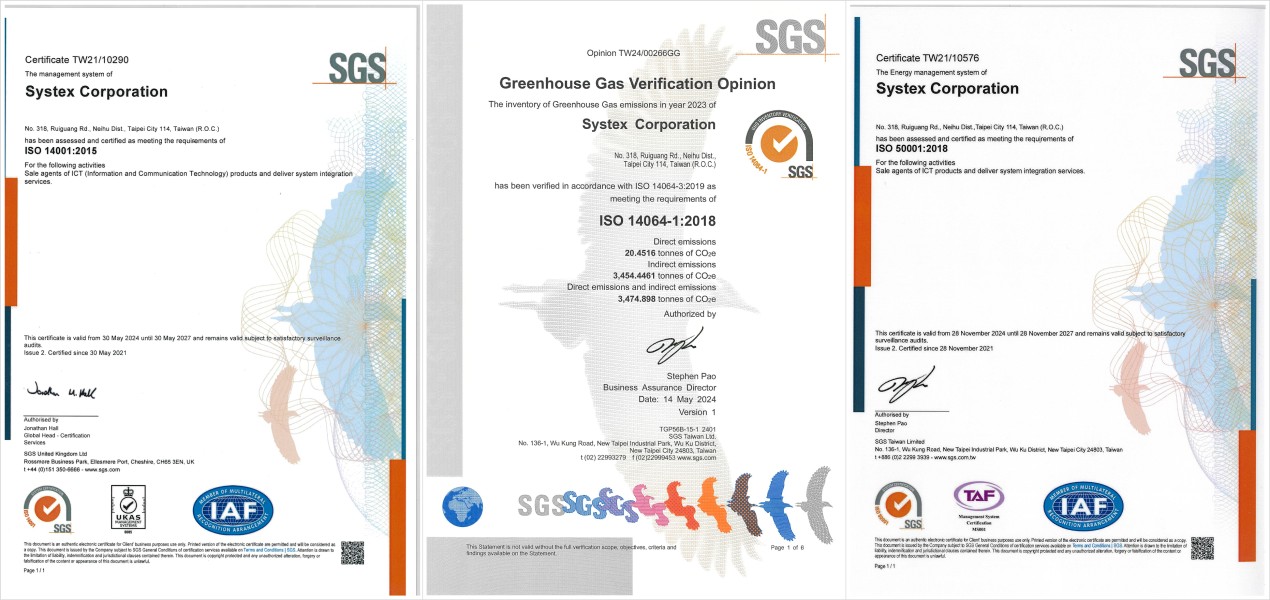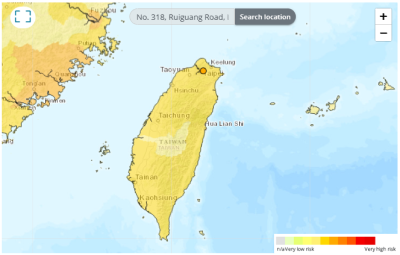Environment & Energy Management
Conduct and obtain the certifications of ISO 14001, ISO 50001, ISO 14064-1
- ISO 14001 Environmental Management System (Valid period: 2024/05/30-2027/05/30)
- ISO 14064-1 Greenhouse Gases Verification Statement (Inventory of GHG emissions in year 2024, 2025/6/16)
- ISO 50001 Energy Management System (Valid period: 2024/11/28-2027/11/27)

Environment Management
Environmental and Energy Monitoring Plan
| Monitoring item | Indicator | Approach | Frequency |
| Drinking water quality | E. coli | Outsourcing | Quarterly |
| Greenhouse gas inventory | GHG emission | Internal | Annually |
| Fire drill | Drill | Internal | Quarterly |
| Water consumption in offices | Water use | Internal | Monthly |
| General waste in offices(trash) | Waste weight | Outsourcing | Monthly |
| Recycling waste in offices | Recycling weight | Outsourcing | Monthly |
| Identify internal and external issues and stakeholder concerns | — | Internal | Annually |
| Environment review | — | Internal | Annually |
| Energy review and baseline | — | Internal | Annually |
| Laws and regulations | — | Internal | Quarterly |
| Achievement of goals | — | Internal | Quarterly |
| Achievement of management plans | — | Internal | Irregularly |
| Energy data collection plans | — | Monitoring | Continuously |
| Internal audits for ISO 14001, ISO 50001, and ISO 14064-1 | — | Internal | Annually |
| Management review meetings of ISO 14001 and ISO 50001 | — | Internal | Annually |
| External audits for ISO 14001, ISO 50001, and ISO 14064-1 | — | Outsourcing | Annually |
Note 1: The internal audits for ISO 14001 and ISO 50001 cover 100% of SYSTEX’s scope.
Note 2: The external audits for ISO 14001 and ISO 50001 were conducted at SYSTEX’s headquarters, which accounts for a 62.25% data coverage rate.
Environment Management Measures
Office water stewardship
- Since SYSTEX is an IT service company, its water usage is only for daily use in the offices, with no production processes that generate water consumption or wastewater.
- Formulate measures in response to drought relief issues, including emergency storage tanks.
- Regularly implement water quality inspection for drinking water and cooling water system to ensure water safety.
- Regularly inspect and maintain pipelines to avoid water leakage.
- Adjust the air conditioning and cooling water drainage, and renew the water chillers of the headquarters building.
- Facilitate dedicated employees’ water management training thought regular testing of the water chiller system.
- SYSTEX headquarters building is fully equipped with sensor faucets and water economizers of toilets to save water.
- SYSTEX puts up the water-saving signs in the pantry room to promote environment protection.
2024 Target
- Water usage per revenue: -1% /per year
2024 Performance
- Water usage per revenue:
230.2 kL/NT$100M (+4.9% /annually)
2025 Target
- Water usage per revenue: -1% /per year
Office paper management
- Use recycled paper from non-confidential and non-personal documents to promote paper-saving awareness.
- In accordance with the Personal Data Protection Act, confidential documents are regularly collected and securely destroyed using water-based disposal methods.
- Implement e-forms and use rental eco-friendly copy machines with MOE-certified eco-labels.
2024 Target
- Paper usage per revenue: -3% /per year
2024 Performance
- Paper usage per revenue:
4,758 sheets (-27.4% /annually)
2025 Target
- Paper usage per revenue: -3% /per year
Waste management
- As an IT service company, SYSTEX does not generate hazardous or polluting waste.
- In compliance with the Waste Disposal Act and other relevant regulations, all IT-related waste follows a specific disposal process before being handled by recyclers to prevent data leakage.
- Collect waste-related data monthly to help SYSTEX enhance waste management and minimize environmental impact.
2024 Target
- Total waste per revenue: -1% /per year
2023 Performance
- Total waste per revenue:
0.37 tons/NT$100M (-13.2% /annually)
2025 Target
- Total waste per revenue: -1% /per year
Water Stewardship
As the global risk report indicates that “extreme climate events” will pose the highest risk worldwide in the next decade, it highlights the urgent need to address the climate crisis driven by these events. This urgency has prompted countries and corporate organizations to expedite their management of climate-related issues. Although SYSTEX is an IT service company, and its water usage is only for daily use in offices, with no production processes that generate water consumption or wastewater, it is important to consider that Taiwan, despite having relatively abundant rainfall, faces challenges in water resource management due to its topography, population density, per capita water use, and the substantial demand for water in agriculture and high-tech industries. Therefore, SYSTEX aligns with the government’s water conservation policy, conducts annual internal audits of water usage, and enhances water efficiency through ongoing tracking and management.
Water Risk
- The boundary of the SYSTEX internal inventory of water resources is defined by the Neihu headquarters building.
- Through the WWF Global Water Risk Assessment Tool (WWF Risk Filter Suite), a thorough review of the water resource risk situation in the area where the headquarters is located indicates that the physical risks in the watershed are low to medium, with the primary risk issues being potential water shortages and degradation of the surrounding soil. Furthermore, using the current trend scenario to forecast water resource risks in 2030, the basin physical risks remain at moderate to low to moderate levels.
- The Neihu headquarters building is located in Taipei City, and all water is obtained from the Taipei Water Department under Taipei City Government. Since all water is daily use in the office, and the wastewater after use is sent to the sewage treatment plant through the sewer, there is no impact on the surrounding environment or community.
Water Risk Analysis

SYSTEX made disclosures with reference to GRI 303. The internal inventory boundary is the Neihu Headquarters building, and the water used is all daily use in the offices, with no production processes that generate water consumption or wastewater.
| Water withdrawal (GRI 303-3) | |||
| All areas (kL) | Water stress area | ||
|
0 | NA | |
|
0 | NA | |
|
0 | NA | |
|
0 | NA | |
|
Freshwater | 24,615 | NA |
| Other water | 0 | NA | |
| Total water withdrawal | 24,615 | NA | |
| Water discharge (GRI 303-4) | ||
| All areas (kL) | Water stress area | |
|
0 | NA |
|
0 | NA |
|
0 | NA |
|
24,615 | NA |
| Total water discharge | 24,615 | NA |
| Water consumption (GRI 303-5) | ||
| All areas (kL) | Water stress area | |
| Total water consumption | 0 | NA |
Note 1. The third-party for water withdrawal at SYSTEX headquarters building is the Taipei Water Department under Taipei City Government.
Note 2. The third-party for water discharge is the sewage treatment plant cooperated with the city water supplier.
Note 3. SYSTEX is an IT service company, with no production processes that generate water consumption or wastewater.
Energy Management
Energy Conservation Measures
Air conditioners
- Continuously replace the AC water pumps at HQ to improve energy efficiency.
- In 2023, 2 energy-consuming AC units in the Data Center were replaced, reducing electricity consumption by 71,744 kWh in a year.
- In 2024, the HQ and data center set up a variable frequency system of chiller units, saved 156,634 kWh and reducing 74.2 tCO2e, and cut electricity costs by NT$70 thousand.
Water chillers
- Through EMS analysis and management, the AC units host capacity of each floor can be used by 2 floors.
- In 2023, SYSTEX replaced HQ-B1 water chiller and adopted EMS high-efficiency control, reducing electricity consumption by 60,000 kWh in a year.
- In 2024, the chiller unit replacement at HQ’s 1st floor has saved 38,808 kWh, reduced 18.4 tCO2e emissions and cut electricity costs by NT$170 thousand.
Energy management system, EMS
- In 2022, SYSTEX optimized AC operation via EMS, reducing load and runtime by introducing external air outside of summer to enhance energy efficiency. This measure contiues to operate steadily.
Internal carbon pricing mechanism
- Since 2024, SYSTEX has implemented an internal carbon pricing mechanism, imposing internal carbon fees to support RE consumption and reduce carbon emissions. This initiative involves an investment of NT$1.5M in RE consumption, resulting in a 260,000 kWh RE usage with a 4.6% RE share, reducing 123.2 tCO2e emissions.
Awareness signage
- At headquarters, SYSTEX displays calorie consumption signs with health slogans in stairwells, encouraging employees to take the stairs instead of elevators to save energy and promote daily wellness.
- Resource recycling slogans were also placed in the headquarters’ pantries to promote recycling actions and enhance recycling awareness.
Note: In 2024, the energy-saving investment for replacing air conditioning units and chilled water units exceeded NT$5.7 million.
Renewable Energy
In response to the international trend of renewable energy and the development of relevant regulations, SYSTEX first adopted T-REC to increase the proportion of renewable energy usage. Then, SYSTEX has signed a Power Wheeling Contracts in 2022 for consuming renewable energy by 120,000 kWh annually, and uses green electricity by PPA since 2023 to gradually increase the renewable energy consumption rate. At the same time, considering the issue of increased carbon emissions caused by the scale of the data center business, an internal carbon pricing mechanism is planned in 2023 and implemented in 2024. After charging internal carbon fees, all funds are dedicated exclusively to using renewable energy in data centers to further increase the renewable energy share.
In 2024, SYSTEX launched an internal carbon pricing mechanism, imposing NT$1,339 in internal carbon fees. All proceeds were exclusively allocated to supporting renewable energy use at the headquarters data center, resulting in an additional 140,000 kWh of renewable energy consumption and raising the data center’s renewable energy share to 3.8%. That year, total RE usage reached 260,000 kWh with a 4.6% RE share, surpassing the 4% target, reducing carbon emissions by 123.2 tCO2e and receiving 260 T-RECs.
Renewable Energy Targets & Performance
- The SYSTEX headquarters building is its own asset, so the renewable energy usage target is set within the headquarters building.
2024 Target
- Renewable energy share: 4%
2024 Performance
- Renewable energy share: 4.6%
2025 Target
- Renewable energy share: 9%
2027 Target
- Renewable energy share: 14%
2030 Target
- Renewable energy share: 20%
2040 Target
- Renewable energy share: 60%
2050 Target
- Renewable energy share: 100%
2024 Electricity Consumption Table
| Electricity consumption (kWh) |
Renewable energy (kWh) |
T-REC | Renewable energy share |
Category 2 emission (tCO2e) |
|
| Location-based | Market-based | ||||
| 5,706,923 | 260,000 | 260 | 4.6% | 2,581.84 | 2,581.84 |
3-year Renewable Energy Consumption (kWh)
Energy usage statistics
| Item | 2020 | 2021 | 2022 | 2023 | 2024 |
| Energy consumption (GJ) (including electricity, gasoline, nature gas and diesel) | 20,642.228 | 19,989.307 | 20,462.718 | 21,104.759 | 20,590.488 |
| Energy consumption (including electricity, gasoline, nature gas and diesel)(MWh) | |||||
|
5,733.94 | 5,552.58 | 5,684.08 | 5,862.42 | 5,719.58 |
|
5,633.94 | 5,480.58 | 5,600.59 | 5,742.42 | 5,459.58 |
|
100 | 72 | 83.493 | 120 | 260 |
|
41.86 | 15.70 | 18.99 | 52.23 | 12.65 |
|
5,692.08 | 5,536.88 | 5,665.09 | 5,810.19 | 5,706.92 |
Note: The total energy consumption = [A1 + A2 (classified by renewable resources or not)] = [B1 + B2 (classified by electrical resources or not)]

